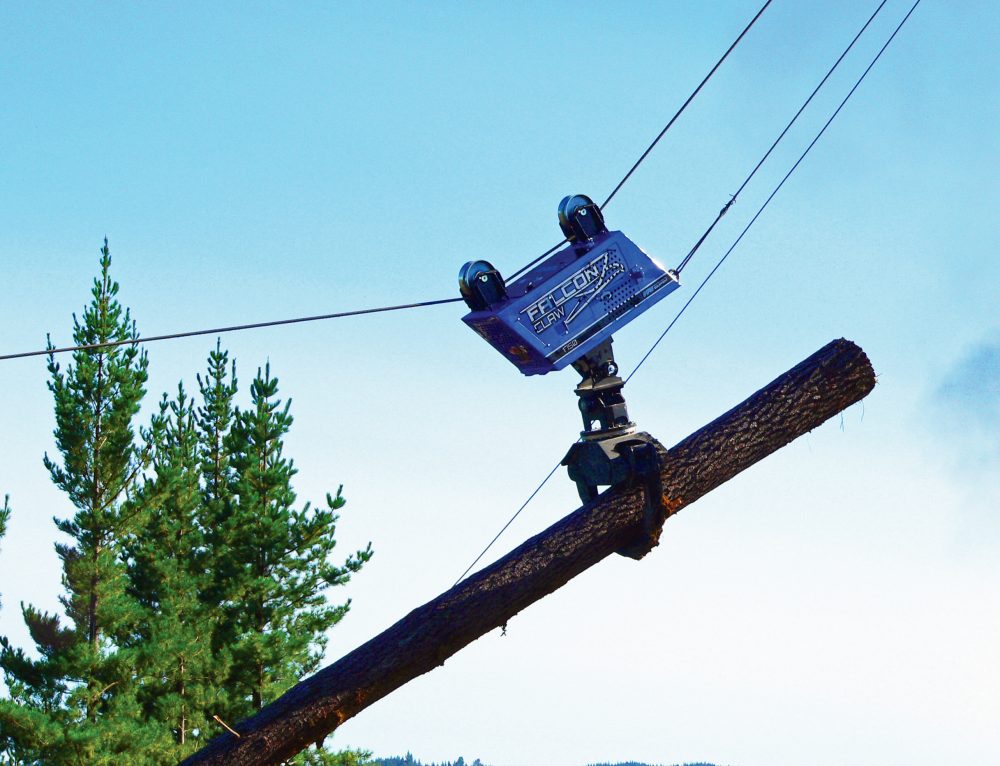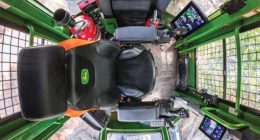A new online guide about how to make the best use of motorised grapple carriages for recovering wood from steep slope forests has been produced by DC Equipment of New Zealand.
Motorised grapple carriages seem to have been around for ages and have revolutionised the way many steep forests are harvested around the world. And yet, there is still some reluctance to use them in certain settings or at all.
So DC Equipment, which pioneered the wide use of motorised grapple carriages more than a decade ago, has produced an online guide to help foresters unlock their potential.
“The industry leaders who have recognised the potential of grapple carriages are seeing beneficial results in their operations, in addition to addressing the obvious safety concerns regarding the vulnerability of people working in dangerous situation,” said Dale Ewers, owner of DC Equipment, which developed the highly successful Falcon Claw motorised grapple carriage.
“These include the solving of recruitment shortages for high-risk environments while increasing workflow and productivity on skid sites. We can’t pin the benefits to one or two points, more rather that crews are seeing an improvement across the wider harvesting process.
“To make the best use of a motorised grapple carriage requires forward planning and that’s what we’ve aimed to cover in our new online guide.
“Logging isn’t easy and there will always be challenges making a motorised grapple carriage work in certain settings, but there’s always a solution.
“It’s known in the industry that contractors have their own approach to how they’ll successfully harvest their blocks. They’ll know what has been working for them and the challenges they have – we’re just being open and advising that in similar settings, we’ve had excellent results by utilising motorised grapple carriage combined with forward planning and accommodating the change in harvest methodology.
“How we used to log 30 years ago and how we’re logging now has completely changed. How we log in the next 30 years will also be completely different, so being open to other harvesting strategies and improving current methods is a large component of increasing productivity.”
Ewers said it is accepted that motorised grapples carriages are suited to shorter pulls and where there is good deflection, but he added: “You’re not going to find the ideal setting every time, so you have to think more creatively.
“For instance, with concave/convex slopes you’re going to have a mixture of good and poor deflection, so when planning your setting it makes sense to identify a tree that can be used as a tail spar or maybe one that can be used as an intermediate spar to raise the height of the rope and keep the grapple carriage and wood off the ground. Or use a block to pull from a different direction to improve deflection.”
Ewers said the main reason he developed the Falcon range of motorised grapple carriages was for the safety of his employees – removing people from the dangerous task of hooking strops to trees on steep slopes is seen one of the most successful ways of preventing harm in the forest.
But once they were introduced to his crews, they soon found there were numerous other advantages.
For example, as yarder operators become experienced in using a motorised grapple carriage, cycle times will drop and logging operations become more productive.
There’s also a misconception that motorised grapple carriages can only successfully be used with tower haulers and are not suited to swing yarders or yarder/loaders, being too heavy and bulky, resulting in mechanical grapples being retained as the first option.
However, new generation lightweight motorised grapple carriages that have been designed specifically for these types of yarders, are proving their worth in a variety of terrain, not just on steep slopes. These include environmentally sensitive areas in what would normally be a ground-based operation butwhere extracting trees or logs with skidders and forwarders will have a detrimental effect on the land or it’s just too difficult. Putting the tail hold on higher ground or using a tail spar to provide deflection keeps surface disturbance to a minimum.
And with the latest high quality, durable cameras fitted to motorised grapple carriages providing the operator with a excellent view of felled trees on the ground, another bonus is that there’s no need for a spotter on the hill, as required with mechanical grapples.
“Put simply, if you are smart about the way you can make a motorised grapple carriage work in your crew, you’re going to be better off in a number of ways – operationally, financially, health & safety-wise and environmentally,” Ewers added.
For more information, check out the new Ultimate Guide to Motorised Grapple Carriages Ultimate Guide to Motorised Grapple Carriages.


